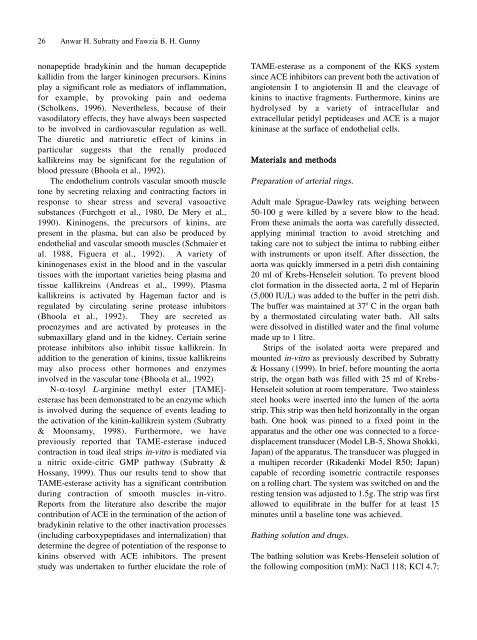Full Journal - Journal of Cell and Molecular Biology - Haliç Üniversitesi
Full Journal - Journal of Cell and Molecular Biology - Haliç Üniversitesi
Full Journal - Journal of Cell and Molecular Biology - Haliç Üniversitesi
Create successful ePaper yourself
Turn your PDF publications into a flip-book with our unique Google optimized e-Paper software.
26 Anwar H. Subratty <strong>and</strong> Fawzia B. H. Gunny<br />
nonapeptide bradykinin <strong>and</strong> the human decapeptide<br />
kallidin from the larger kininogen precursors. Kinins<br />
play a significant role as mediators <strong>of</strong> inflammation,<br />
for example, by provoking pain <strong>and</strong> oedema<br />
(Scholkens, 1996). Nevertheless, because <strong>of</strong> their<br />
vasodilatory effects, they have always been suspected<br />
to be involved in cardiovascular regulation as well.<br />
The diuretic <strong>and</strong> natriuretic effect <strong>of</strong> kinins in<br />
particular suggests that the renally produced<br />
kallikreins may be significant for the regulation <strong>of</strong><br />
blood pressure (Bhoola et al., 1992).<br />
The endothelium controls vascular smooth muscle<br />
tone by secreting relaxing <strong>and</strong> contracting factors in<br />
response to shear stress <strong>and</strong> several vasoactive<br />
substances (Furchgott et al., 1980, De Mery et al.,<br />
1990). Kininogens, the precursors <strong>of</strong> kinins, are<br />
present in the plasma, but can also be produced by<br />
endothelial <strong>and</strong> vascular smooth muscles (Schmaier et<br />
al. 1988, Figuera et al., 1992). A variety <strong>of</strong><br />
kininogenases exist in the blood <strong>and</strong> in the vascular<br />
tissues with the important varieties being plasma <strong>and</strong><br />
tissue kallikreins (Andreas et al., 1999). Plasma<br />
kallikreins is activated by Hageman factor <strong>and</strong> is<br />
regulated by circulating serine protease inhibitors<br />
(Bhoola et al., 1992). They are secreted as<br />
proenzymes <strong>and</strong> are activated by proteases in the<br />
submaxillary gl<strong>and</strong> <strong>and</strong> in the kidney. Certain serine<br />
protease inhibitors also inhibit tissue kallikrein. In<br />
addition to the generation <strong>of</strong> kinins, tissue kallikreins<br />
may also process other hormones <strong>and</strong> enzymes<br />
involved in the vascular tone (Bhoola et al., 1992)<br />
N-α-tosyl L-arginine methyl ester [TAME]esterase<br />
has been demonstrated to be an enzyme which<br />
is involved during the sequence <strong>of</strong> events leading to<br />
the activation <strong>of</strong> the kinin-kallikrein system (Subratty<br />
& Moonsamy, 1998). Furthermore, we have<br />
previously reported that TAME-esterase induced<br />
contraction in toad ileal strips in-vitro is mediated via<br />
a nitric oxide-citric GMP pathway (Subratty &<br />
Hossany, 1999). Thus our results tend to show that<br />
TAME-esterase activity has a significant contribution<br />
during contraction <strong>of</strong> smooth muscles in-vitro.<br />
Reports from the literature also describe the major<br />
contribution <strong>of</strong> ACE in the termination <strong>of</strong> the action <strong>of</strong><br />
bradykinin relative to the other inactivation processes<br />
(including carboxypeptidases <strong>and</strong> internalization) that<br />
determine the degree <strong>of</strong> potentiation <strong>of</strong> the response to<br />
kinins observed with ACE inhibitors. The present<br />
study was undertaken to further elucidate the role <strong>of</strong><br />
TAME-esterase as a component <strong>of</strong> the KKS system<br />
since ACE inhibitors can prevent both the activation <strong>of</strong><br />
angiotensin I to angiotensin II <strong>and</strong> the cleavage <strong>of</strong><br />
kinins to inactive fragments. Furthermore, kinins are<br />
hydrolysed by a variety <strong>of</strong> intracellular <strong>and</strong><br />
extracellular petidyl peptideases <strong>and</strong> ACE is a major<br />
kininase at the surface <strong>of</strong> endothelial cells.<br />
Materials <strong>and</strong> methods<br />
Preparation <strong>of</strong> arterial rings.<br />
Adult male Sprague-Dawley rats weighing between<br />
50-100 g were killed by a severe blow to the head.<br />
From these animals the aorta was carefully dissected,<br />
applying minimal traction to avoid stretching <strong>and</strong><br />
taking care not to subject the intima to rubbing either<br />
with instruments or upon itself. After dissection, the<br />
aorta was quickly immersed in a petri dish containing<br />
20 ml <strong>of</strong> Krebs-Henseleit solution. To prevent blood<br />
clot formation in the dissected aorta, 2 ml <strong>of</strong> Heparin<br />
(5,000 IU/L) was added to the buffer in the petri dish.<br />
The buffer was maintained at 37 0 C in the organ bath<br />
by a thermostated circulating water bath. All salts<br />
were dissolved in distilled water <strong>and</strong> the final volume<br />
made up to 1 litre.<br />
Strips <strong>of</strong> the isolated aorta were prepared <strong>and</strong><br />
mounted in-vitro as previously described by Subratty<br />
& Hossany (1999). In brief, before mounting the aorta<br />
strip, the organ bath was filled with 25 ml <strong>of</strong> Krebs-<br />
Henseleit solution at room temperature. Two stainless<br />
steel hooks were inserted into the lumen <strong>of</strong> the aorta<br />
strip. This strip was then held horizontally in the organ<br />
bath. One hook was pinned to a fixed point in the<br />
apparatus <strong>and</strong> the other one was connected to a forcedisplacement<br />
transducer (Model LB-5, Showa Shokki,<br />
Japan) <strong>of</strong> the apparatus. The transducer was plugged in<br />
a multipen recorder (Rikadenki Model R50; Japan)<br />
capable <strong>of</strong> recording isometric contractile responses<br />
on a rolling chart. The system was switched on <strong>and</strong> the<br />
resting tension was adjusted to 1.5g. The strip was first<br />
allowed to equilibrate in the buffer for at least 15<br />
minutes until a baseline tone was achieved.<br />
Bathing solution <strong>and</strong> drugs.<br />
The bathing solution was Krebs-Henseleit solution <strong>of</strong><br />
the following composition (mM): NaCl 118; KCl 4.7;

















